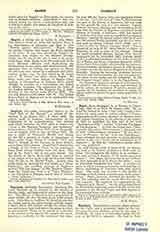

Bagshaw, CHRISTOPHER, convert, priest, prisoner for the Faith, and a prominent figure in the controversies between Catholic priests in the reign of Elizabeth. He came of a Derbyshire family, but the year of his birth is unknown. He died in Paris sometime after 1625. Bagshaw was at St. John’s College, Cambridge, in 1566, was graduated B. A. at Balliol, Oxford, 1572, and probably became a Fellow of that college in the same year. As a Fellow he was a party to the expulsion from the college of the afterwards famous Jesuit, Father Parsons.
At proceeding M. A. in 1575, Bagshaw was still a zealous Protestant. His administration as Principal of Gloucester Hall (1579) was unpopular and brief. In 1582, in France, he became a Catholic and was ordained a priest. Going to Rome with the permission of Cardinal Allen, he entered the English College. It is said by Bullen, that he was expelled by Cardinal Boncompagni for his quarrelsome temper and unpopularity. Foley’s list of students of the English College does not contain his name. Later, at Paris he proceeded doctor of divinity and doctor of the Sorbonne, though afterwards he was dubbed by his Jesuit opponents doctor erraticus, doctor per saltum. On his return to England he was imprisoned (1587) in the Tower of London, under the statute of 27th of Elizabeth, an act against Jesuits and Seminarists. (The text of this law is in Hardy and Gee.) With a number of other priests out of the more than 400 laboring in England, he was imprisoned in Wisbeach Castle, 1593.
There now came to a head a factional division among the laborers on the English mission. There were two original sources of difference: the existence of a Spanish faction, headed by the Jesuits, and the Jesuits’ control of the English College at Rome (Cf. Dodd and Tierney; Lingard). The partisan feelings aroused found vent in two controversies in which Bagshaw was prominent, if not first, on the side opposed to the Jesuits and their friends. The earlier dispute, arbitrated after nine months, arose from the vigorous opposition of Bagshaw and the elder clergy to the introduction of a religious rule among the thirty-three priests in Wisbeach Castle. Later, when, partly for the purpose of consolidating English Catholic sentiment in favor of a Catholic successor to Elizabeth, Cardinal Cajetan placed at the head of the English Mission, as archpriest, Father George Blackwell, with instructions to consult the Jesuit provincial on matters of importance (Lingard VIII, vii), Bagshaw headed a party of protest, which, on being disciplined, appealed, with the secret aid of Elizabeth‘s government, to Rome. Their appeal was in part successful, though the appointment was confirmed.
Bagshaw, after his liberation, resided abroad, and is described in Daniel Featley’s “Transubstantiation Exploded” as having been Rector of Ave Maria College. This work was published in 1638, and contained notes of a public disputation with Bagshaw. His death and burial, at Paris, occurred after 1625. He may have written in part “A true Relation of the Faction begun at Wisbich by Father Edmonds, alias Weston, a Jesuit, 1595, and continued since by Father Walley, alias Garnet, the Provincial of the Jesuits in England, and by Father Parsons in Rome” (1601); “Relatio Compendiosa Turbarum quas Jesuitae Angli una cum D. Georgio Blackwello, Archipresbytero, Sacerdotibus Seminariorum, Populoque Catholico concivere”, etc. (Rouen, 1601).
J. V. CROWNE

